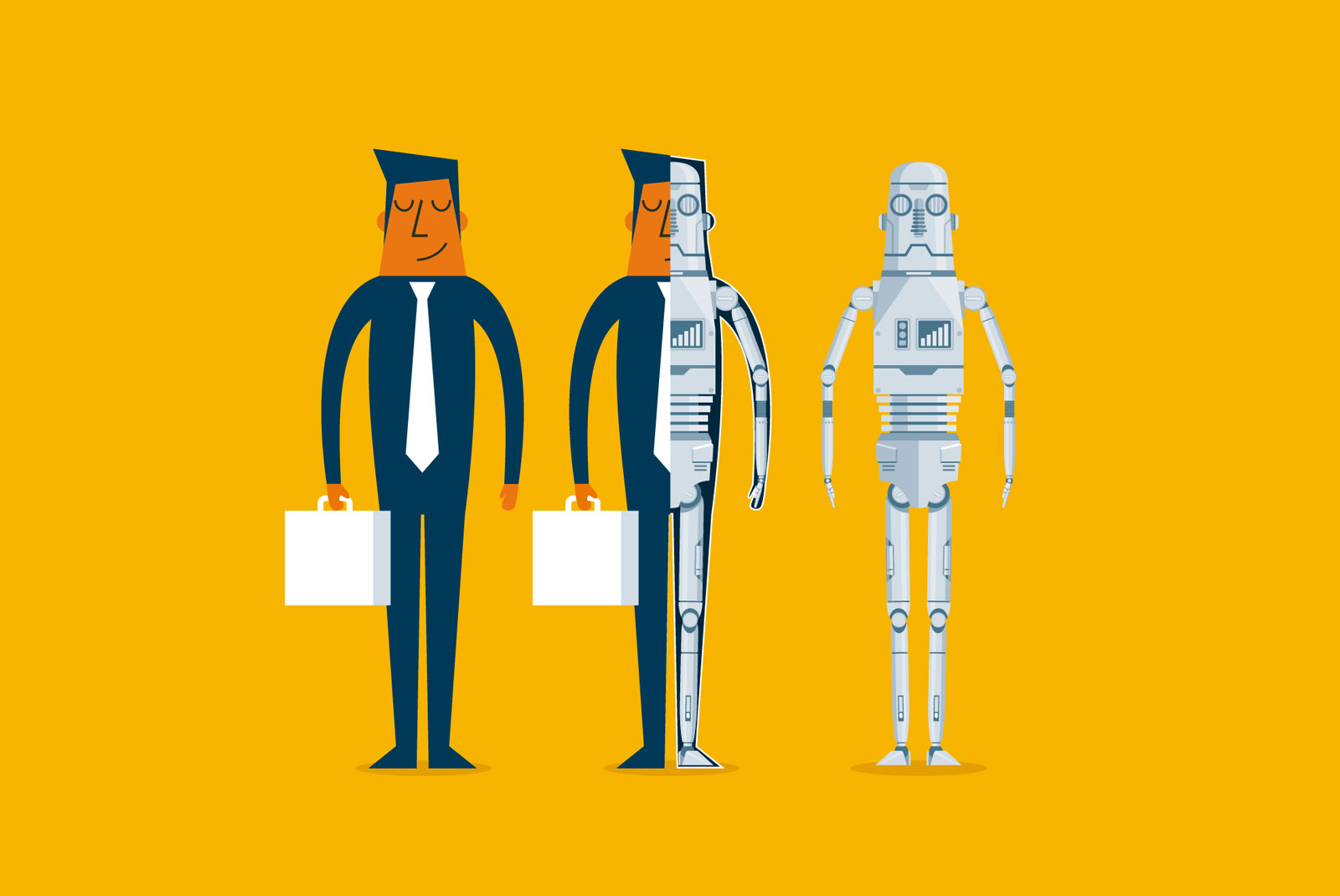
The mention of artificial intelligence immediately brings to mind the image of a robot, and this robot is very different depending on the part of the world were it’s being imagined —or crafted—.
Japanese kids learn at a very early age that if they need help and they cry enough a Gadget Cat from the Future will come to help. This situation is a bit more rare in the Occident, where you can say it’s more common that if a robot hears you cry it’ll kill you because the noise is annoying it.
That’s the reason why in Japan they have anime shows like Doraemon, while westerners stress about maniac robots. Terminator, Replicants, the "hosts" gang at Westworld. Most people see robots as cute companions; but there are others who stay awake at night thinking of the moral and safety implications of giving birth to an intelligent and automated system.
It’s a cultural matter that exemplifies how people in different parts of the world feel about technology — with excitement or with fear. Artificial intelligence is either here to annihilate us (and our jobs), or help us shop by offering whatever you want, at the touch of a button — this is the true power of e-commerce and the smartphone.
We are still in early stages of artificial intelligence, but these arguably revolutionary technologies are not a menace, nor are they a magic solution.
The question is whether they will be a help or a hindrance. The repercussions of machine intelligence depend on how companies approach machine learning and how they take the lead and begin development at an early stage, before it’s too late to keep pace with a rapidly evolving industry.
“We’re kidding ourselves if we think that the market is going to, on its own, allow these technologies to infiltrate and yield the kind of outcomes from society that we want.”
Diana Farrell, JPMorgan Chase Institute CEO
Those words were heard at a summit organized by MIT on the matter, where it became clear that artificial intelligence offers as much commercial and industrial promise as it does confusion and ethical hand-wringing. We can teach robots to play Jenga or build skyscrapers — from daily uses to ambitious projects, and vice versa. Technology can fit wherever we need it… if the terms are defined first.
It’s your duty to decide where you want it, and if you want it now.
Table of contents
- The robot we deserve: Business Intelligence
- Siri, how much does a robot cost? AI more accessible to businesses
- Safety mode: What are the dangers of artificial intelligence?
- How can AI be beneficial for e-commerce?
- It’s not sci-fi, it’s the future. The next big thing in artificial intelligence
The robot we deserve: Business Intelligence
Artificial intelligence is often also referred to as machine learning development, a field where AI tech companies like Perception Box celebrate that machines “can do incredible things and outperform any human”. A slogan like that sounds pretty scary, and perpetuates the debate around the perils of driverless cars and delivery drones — will robots, machines and software systems take our place, while humans return to the factories as the only job left will be building more robots?
That’s where the misunderstanding begins: artificial intelligence is more than just robots. Machine learning also encompasses systems that gather and use data in an automated way, like credit scoring, predictive sales, or client profiling.
The big problem here is not that artificial intelligence systems can get out of control, but that there is not enough knowledge, expertise, professional understanding, and automated curation data.
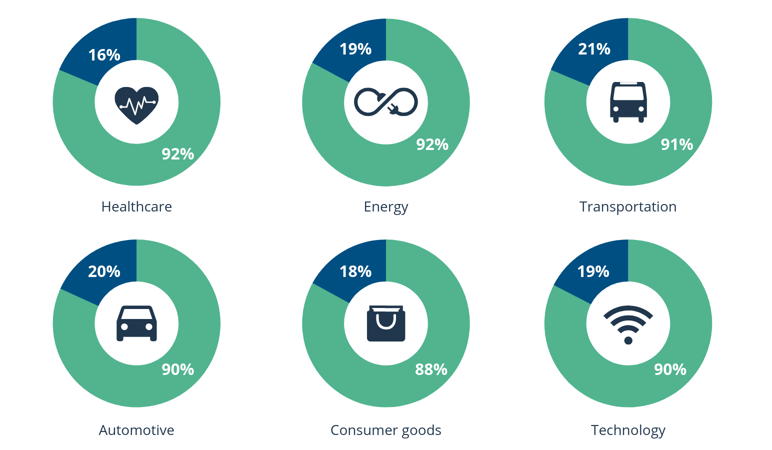
Early adopters are still the minority in all industries regarding artificial intelligence systems, though its applications are demonstrably positive for all of them. As some surveys performed across different verticals show, transportation and car manufacturing are the trending sectors in the use of artificial intelligence, because the majority of businesses link technology to physical tasks and they don’t stop to consider that there are other daily tasks that can be automated and enriched too.
Healthcare, and Mining and Minerals are other sectors where artificial intelligence is getting more attention, but they’re still very low numbers, as Healthcare is the biggest and it’s actually only 15% of the industry. Retail and Telecommunications follow close behind them, as we’ll see more in depth later.
A ghost still in the shell: The unbalanced global AI development
As it happens in many other industries, Europe is the turtle in this race, and Northern European countries and the Anglo-Saxon countries are the only ones leading the development and implementation of artificial intelligence systems. Even they are far away from the United States and China, as according to the latest comparisons the digital portion of Europe’s ICT sector is 1.7 percent of GDP, while China is at 2.1 percent and the USA at 3.3 percent.
The irony of this is that Europe has six million professional developers, a way more than in the United States. The continent has surpassed its development stage, but it need the global investment in artificial intelligence that could give a boost to general European economy, estimated up to a 1.4 percent annual growth through 2030.
Japan, China, the United States, South Korea and Germany are leading the artificial intelligence market worldwide, with companies like Kawasaki, Yaskawa, ABB, Fanuc or KUKA. But AI companies are not only dedicated to robot design, we also count here software and tech companies that are part of the automation industry.
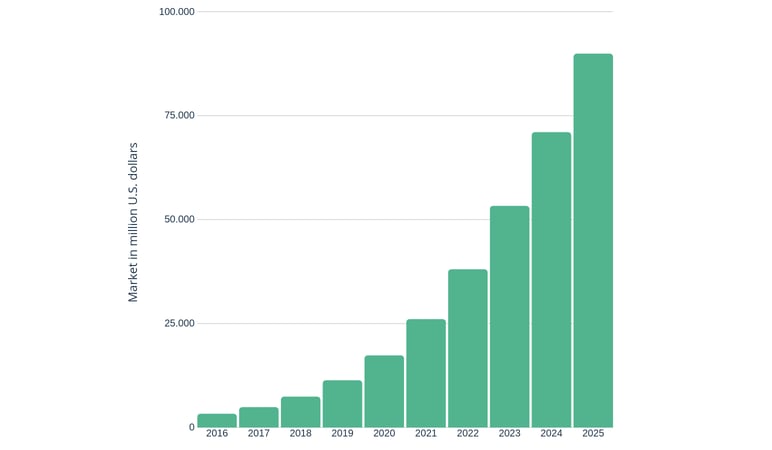
Systems that may or may not complement their use with some device or sensor, and that aim to automate repetitive processes, improve performance, optimize resources, and bring valuable data or business intelligence. Companies need to understand that the volume of data managed year after year is increasing at an unwieldy level in a worldwide market where more factors are being added to the equation every year.
It’s not only their own service data at risk, but also the data from their partners, vendors, reps, clients, new projects, and hypothetical scenarios. Artificial intelligence systems are here as invisible programs inside computers that can analyze business risks and the most promising options. But first we have to invite them in.
“The Internet is another way to increase optimization in the transmission of information throughout the history of mankind. The next step is to provide more intelligence to the generation and distribution of product information so that it reaches the consumer efficiently, quickly and with a high level of credibility.”
What are the main fears of companies about artificial intelligence?
As this survey reports, the main reasons for low use of machine learning and automated systems in businesses are:
- The complexities of finding the right software and provider.
- The misconception about artificial intelligence only developed for science industries or IT teams.
- Marketers could not understand the features of sophisticated technologies.
- The lack of product management skills to live up to the technology’s demands.
- The need of hiring specialized employees before implementing any AI technology.
- High levels of flexibility and progressive decisions (not common in their businesses).
There are lots of wrong ideas and fears nurtured by a general disinformation about how artificial intelligence and automation technologies can really help businesses. Money and complexity are the main obstacles for companies, but time is the elephant in the room: according to this Accenture Technology Vision 2019 survey, 94% of businesses and executives say that the pace of technology innovation in their organizations had accelerated too much in the past years, and only 45% of them have deployed some AI program regarding this situation.
Teams are afraid of not being able to keep pace with the technology revolution, and as stupid as it sounds, many companies choose to bury their heads in the sand, waiting for others to test the novelties before calibrating the efforts and investments needed for any new system implementation and employees training.
At the same time, businesses recognize that artificial intelligence systems will allow them to gain competitive advantage, improve their workforce, and develop new products, services, business models, and market expansions.
Why are businesses so scared then, and how could they overcome those fears?
“AI will help brands create customized experiences that make the individual more likely to purchase. Machine learning will improve the efficiency of targeting digital advertising, and it will make companies better at forecasting demand and creating products people want.”
Ryan Markman, Metric Digital
The next challenges and steps: What if we push this button…?
Taking lead in the artificial intelligence race will not happen from knee-jerk reactions. Adequate preparation will be fundamental to survive this long marathon, and all signs indicate that machine intelligence and automation systems will offer new detours and crossroads in the near future.
As basic business arrangements, companies should consider these structural changes:
-
Take a chance on artificial intelligence technologies in the most critical areas for the company. For example, Customer Experience and UX are performance keys in the retail industry.
-
Design an investment plan that doesn’t sacrifice resources of proved value in order to make room for too complicated and expensive AI systems.
-
Complement the technology with the flexible and scalable processes and the professionals needed to evaluate the efficiency and correct operation of the new tool, from data analytics to workflows.
-
Consider not only the tool, but also the team needed around it: any company should start its artificial intelligence path by investing in training related skills, new talent, and internal research and innovation.
-
Communicate effectively across different departments and let the decision makers have the results of analytic data, instead of restraining the use of artificial intelligence to technical teams.
Siri, how much does a robot cost? AI more accessible to businesses
If you are thinking about a C3PO type assistant, fluent in over six million languages, and coated in gold, the answer is yes, that kind of artificial intelligence costs an arm and a leg.
Being realistic, the artificial intelligence novelties and advancements that make the headlines are things that most of the time are still at an experimenting stage. Cool dancing robots or virtual assistants that can scan us at home to see if it’s just a stomachache or something more serious. People want to keep dreaming of a world pretty similar to what movies depict, but the real developments are going in other directions which are way more affordable for companies.
Just like Alexa and Siri have made their way into our pockets without too much thinking, other artificial intelligence forms are providing new valuable features low-key. Of course an iPhone or a Google Echo are still expensive gadgets for many people — does that mean that businesses also need to face huge investments if they want some artificial intelligence scraps?
The main realization any company must come to is that revolutionary technological systems need investment in order to increase the revenues. The costs cuts are not going to happen instantly, and artificial intelligence has not been developed to reduce payments and staff, as some experts like to point out.
Machine learning and automation are just tools that sum up to the team and business structure, and any company can begin at the desired level. Software systems that automate accounting, client profiling, talking to customers, tracking inventory, are already affordable to most companies, with beneficial conditions like monthly fees, quick set-ups, official training include, and in-cloud systems that save businesses space and time while they practise with their first artificial intelligence tools.
Safety mode: What are the dangers of artificial intelligence for businesses?
If you were rubbing your hands in excitement for having a list of reasons not to invest in artificial intelligence, we are sorry to disappoint you. The dangers caused by this type of technology are bigger if companies don’t start using them than if they trust them.
Although the implementation of artificial intelligence systems in retail and e-commerce businesses is not high, as we will see, it’s an essential step nowadays to lead your niche, improve internal and external performance, optimize products and services, and build brand reputation in an increasingly competitive worldwide marketplace.
As you can hear in the 2015 movie Ex Machina, “We don't need AI to destroy us, we have our own arrogance”. Businesses that think the time for disruptive technologies is not here yet as they keep saving on software and investing on one-hit strategies like influencers or traditional SEO, are just deluded about how the industry is really evolving.
Maybe we don’t like to admit that now we need more tech than ever, but that is not going to benefit companies that resist the change and arrogantly defend that they are doing good without those savvy gadgets.
"Google has already started testing algorithm variations that incorporate AI and machine learning. Though the impact on live search is still pretty minimal, it's safe to say that it will grow as Google works out the kinks. As Google search better incorporates AI, the impact of search intent will become more important for creating e-commerce conversions via SEO efforts."
Maddy Osman, SEO Content Strategist at The Blogsmith
Do you want to know what businesses are losing by not jumping on the bandwagon?
Industry positioning
The early bird companies that are testing artificial intelligence today will be more prepared for next changes, and will lead any technological transformation in your industry.
Customer retention
Clients are more demanding every day that goes by, and they will always be ready to go to your competitors if they find more secure and faster services. Automation is an essential feature for B2C and B2B companies that value their customer base and want to retain clients with effective customer service, no shipments or answer to queries delays, and tailored communication.
Omnichannel UX
In order to achieve personalized customer experiences, thousands of channels, platforms, departments, countries, and data must be connected super smoothly. The customer must find no error while surfing your online shopping experience, and automation tools that work 24/7 can keep an eye on everything while your team dedicates to the fun and creative part.
Personalized marketing
Giving the same thing to everybody is the greatest no-no for marketing teams. Personalized promotions, mailings, suggestions, and notifications will be impossible to tailor if they are made by hand and one by one. It sounds paradoxical, but the only way to create individualized campaigns is trusting on automated software (that also helps your human team of burning out).
And now some silver lining to cheer you up: here is everything that artificial intelligence is already doing to improve e-commerce businesses.
→ Discover: More intelligence through geomarketing and location data
How can AI be beneficial for e-commerce?
Artificial intelligence systems have benefits for all types of industries that also positively impact on retail and e-commerce businesses:
- Reduces costs (evaluating the manufacturing of products and services after sales data).
- Improves revenue (using machine learning processes to identify the best markets, channels and customers).
- Identifies hidden value inside the company.
- Points out the best market expansions.
- Helps make better decisions (based on data that has scanned a bigger amount of information and variables).
- Enhances KPIs for sales and marketing.
- Finds instant solutions to problems (like customer complaints).
- Optimizes internal workflows and external processes.
- Automates repetitive tasks.
- Gives more space for creativity.
However, AI solutions can be designed and used both as tools that completely replace a worker, or as systems that work for and with the professional, because they perform an automated task that needs interpretation and application — something that can be suggested by a machine, but not decided by it (yet).
The authentic value of an artificial intelligence system for retail and e-commerce businesses is allowing the teams to automate and forget some tasks, not only making those tasks easier, as the volume of contents that people work with in retail is always growing and reaches unbearable levels, like updating in one day thousands of SKUs for a new catalog launch.
Algorithms and automated software are the great companions for retailers and e-commerce marketers nowadays, and it’s a reasonably cheap technology that scales alongside the revenues and customer base of each business. From predicting shopping trends and avoiding cart abandonment to recommending tailored products to visitors and allowing shoppers search items via conversational language or images, machines are humanizing an online shopping experience that was impossible to handle by humans.
It’s a huge irony, but artificial intelligence brings the brick-and-mortar experience to the online world, as shoppers can have much personalized attention and support, in real time.
"AI is already bringing better product recommendations to e-commerce and it will continue to grow. There are lots of tools trying to use AI to make advertising more effective. Currently, it's far from being as effective as a team of smart strategists — but it will probably be there in the next decade or two."
William Harris, CEO and Lead Strategist at Elumynt
In summary, through machine learning retailers can gather more data and, most importantly, contextualize it for useful situations and business improvements that can be decided on the spot, rather than waiting till the next meeting.
It’s no coincidence then that most technologies with greater retail investment are related to automate the input of customer data one way or another:
- Big data solutions
- Tracking sensors (in-store)
- Tracking customer traffic (geomarketing purposes)
- Geolocation tech
- Inventory and supply chain automation
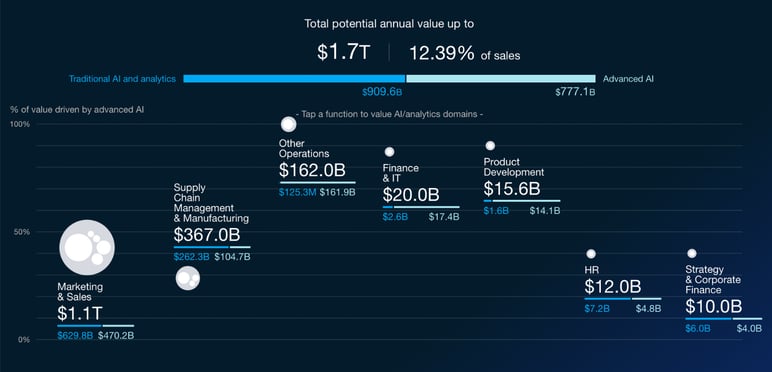
The best uses of artificial intelligence for e-commerce
All solutions based on machine learning look for at least one of this goals in retail, both for offline and e-commerce sales:
- Improve old products
- Launch new products
- Sustain the customer base
- Profile new customers opportunities
- Agilize processes for decision-makers
- Enhance teams and resources
- Prepare new markets
Let’s take a look at the most common uses available nowadays.
Chatbots
They’re like robots, though nobody can’t see them. Offering a top-notch customer service is the first golden rule for any retailer and e-commerce platform. But as an increasing number of customers visit each channel everyday, at any time of the day (as they can be shopping online from Hawaii or Canada), and as those channels also keep growing in number, it’s becoming very difficult for companies to guarantee a quick support service.
The human resources needed for that purpose would be huge, and you don’t need a human face behind every online interaction. After all, nobody is going to be able to tell if it’s really a human face anyway.
Chatbots and virtual assistants are lifesavers that businesses are embracing without a murmur, as they can keep a reasonable customer service human team that takes charge of the most important situations, while the most urgent, common, repetitive or intrusive questions are handled by chatbots.
You can also differentiate between website chatbots (those that welcome users when they open the homepage or any other page you want), and social media chatbots, like Twitter or Facebook accounts connected to businesses (and that can lead a customer from one social media channel to a specific product page, FAQ page, category search, human customer support…). Both can collect data from users and add new customers to your mailing lists.
Surprisingly, according to Statista, only 34% of users feel comfortable when receiving customer service from artificial intelligence. If 80% of businesses estimate to use this type of technology by 2020, as calculated by Oracle, companies will need to figure out how to convince customers that chatbots are better than e-mail and telephone, the most popular communication channels right now.
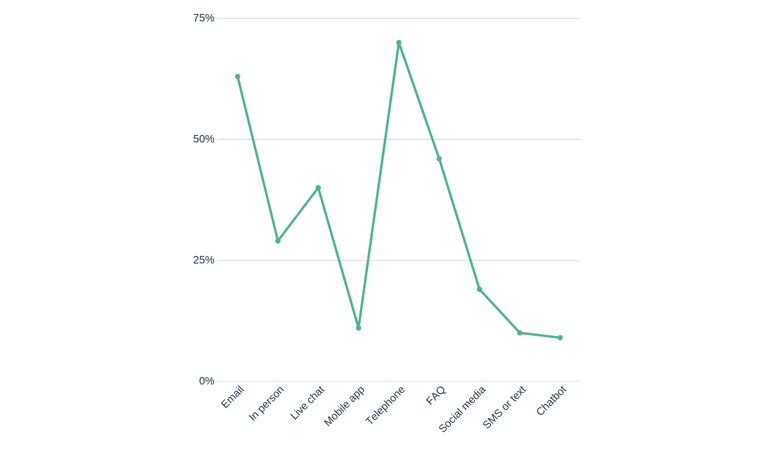
There are other applications for chatbots that can give great revenue for retail businesses:
In-chat shopping: Chatbots can not only suggest products to customers based on their answers, they could even complete the shopping process and payment without leaving the chat window. This would speed up the process and lead to less cart abandonments, as clients could have all their questions about shipping times or costs immediately answered.
Feedback collection: Chatbots offer information to users, but they can take some valuable data in exchange, like opinions and mini reviews that people feel more willing to share via chat, as it’s instantaneous, anonymous and gives the illusion of private talk. That means this technology can be as reactive as proactive.
Content delivery: This application of artificial intelligence is more common among media companies like news, magazines and video content platforms, but retail businesses that also offer some type of product-related content to their customers could also begin to personalize suggested information, tutorials, catalogs, booklets, newsletters, and any other marketing asset in campaigns or on-demand.
→ Read more: How Wrangler localized their websites via cultural tropes
Customer profiling
Through data collected by chatbots, calls transcriptions, reps input, shoppers behavior and purchases history, artificial intelligence systems can interpret all that information and segment the target audience to identify interesting profiles and new niche opportunities.
Personalized customer experience
Customizing the online shopping experience for each visitor is an impossible task for human marketers. Machines can understand in a second what type of customer has entered the website and which promotions, banners, categories and contents could interest them. This way conversions need less time and the higher expectations that lead to better engagement are met.
There is a marketing to-do list that sounds like a list of commandments of the industrial era: research, gather, curate, add, analyze, even drag-and-drop! Manual, repetitive and exhausting tasks that only bring out the worst in people. Machines have no problem receiving those orders and performing them 24/7 if necessary, while human teams focus on creative strategies.
Product discovery
Amazon imposed predictive product recommendations as a compulsory module for retailers in the marketplace and in their own branded websites. They can predict the next need for each user and achieve more expensive shopping carts and overall revenue with combined algorithms.
Of course, a huge database of customer behavior would be the cat’s pajamas for this purpose, as artificial intelligence systems work better if their information source is as accurate and complete as possible. But that’s not an option if you are a retailer without Amazon’s millions of daily customers. Which leads retailers to new and savvy ways of using machine learning to collect customer data and feed the systems with more quality input, like social media and investing in voice assistants and natural language processing technologies.
Dynamic pricing
AI machines can rearrange delivery times and routes to make the shipments more efficient. Their main goal is to make the most of each order with the best revenue for the company, so the first step for the optimization begins at pricing.
Putting the best prices for each product is a competitive task that can change even at a daily rate. New competitors on marketplaces, promo seasons that are constantly arising, and changing industry average prices can confuse companies about when to lower or raise their prices.
Artificial intelligence systems suggest prices readjustments in real time, based on customer data, changes among the competition, and internal sales transactions. Leave to them the responsibility of choosing when to discount things, instead of falling into an infinite loop of dropping prices (and revenues).
→ Related: Online shopping trends that will change e-commerce practices
It’s not sci-fi, it’s the future. The next big thing in artificial intelligence
Image recognition
Online shopping has always been a super visual realm, but users couldn’t search things easily from visual references. Now it’s possible to lead customers to the right product from a photo on social media or even taken with their smartphones, as artificial intelligence systems get more sophisticated for object identification, detection, classification, and geophysical detection.
Anti-fraud
The many possibilities to buy things online imply some risks. For example, voice assistants can be easily tricked, as you’ll know by those funny stories about children buying dozens of dollhouses from Alexa. And that’s only the lesser evil that could happen.
Anti-fraud systems can use biometrics to avoid face, voice and digital fraud and make online shopping processes more trustworthy for customers, but also for companies that can improve their customer experience and reduce business risk exposure.
“The next great development will be in the area of Generative Adversarial Neural Nets (GANs). GANs are those models that can create art. Now they are doing everything from writing copy, producing photo realistic pictures of fake humans, to photo editing. These models will make creating much more interesting and possibly help solve problems with training data.”
Steve Meier, VP of Sales and Marketing at KUNGFU.AI
Final thoughts
As it goes with any technology, work system, or professional guru, artificial intelligence doesn’t guarantee immediate success. It’s a valuable asset that can boost revenue, but that depends on the strategy implemented and on how you use the tools. As Ryan Markman at Metric Digital states, “The secret most companies miss is, you have to test. Even if your budget is low, test everything. Engage your curiosity like your life depended on it”.
You need to supply artificial intelligence tech with good material, data and content to work with — if it’s poor or limited, it won’t offer many good results and the inversion won’t be worth it. Machine intelligence was not invented to amass data just for data’s sake. It must be complemented with a a precise roadmap, the most suitable expertise, and teams in a constant state of training and learning.




.png?width=520&name=Blog%20Partner%20(3).png)

.png?width=520&name=Blog%20Partner%20(1).png)


